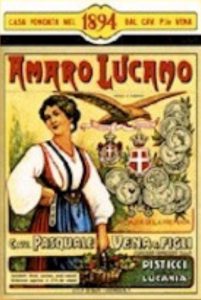 Amaro Lucano is less bitter than some other Italian bitters, though it has no sweetness in it. The recipe, consisting of herbs and roots, is a trade secret. It has a light body to be used as a digesti, or an apéritif. As a digesti, you serve it neat. As an apéritif, you can serve it on ice with a twist of lemon or orange, topped up with soda water.
Amaro Lucano is less bitter than some other Italian bitters, though it has no sweetness in it. The recipe, consisting of herbs and roots, is a trade secret. It has a light body to be used as a digesti, or an apéritif. As a digesti, you serve it neat. As an apéritif, you can serve it on ice with a twist of lemon or orange, topped up with soda water.
It is made in Pisticci Scalo in Basilicata (about 15 km from Craco) Italy, and sold in 700 ml bottles. (30% alcohol.)
History
Amaro Lucano was invented by Pasquale Vena in 1894 (born Pisticci, Basilicata 1871 – died 1937.) His three brothers went to America, but he stayed behind, and went north to Naples in Campania. There, he apprenticed to learn the art of pastry making in a pastry shop called ” the Scaturchio” in Piazza San Domenico Maggiore in Naples (the pastry shop is still extant as of 2006.) Out of his own personal interest, he learned about herbs and herbal mixtures.
He returned to Pisticci, and with the small amount of money he had saved, he opened a Bar called the “Caffé Vena.” The pastries that he sold from the cafe were a success – along with the bitters that he created. He left the firm to his two sons, Leonardo (1910 – 1993) and Giuseppe (aka “Peppino”, born 1918), who were 27 and 19, respectively, at the time.
In July 1965, the company built a new factory to meet increased demand for the bitters.
Literature & Lore
The label has a picture of a woman called “Pacchiana” (apparently a Campanian word for “farmer.”) She’s holding a basket of herbs. The motto on the label is “Lavoro e onestà”, which means “work and honesty.” The label also depicts various medals and awards, and crests from the Savoy and Duchy of Aosta families. In the bottom right corner is written “Pisticci, Lucania.”